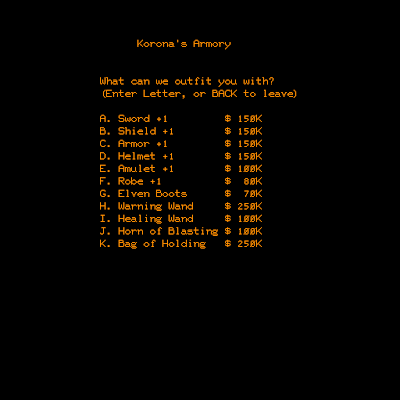Back when I started The Game of Dungeons, I noted that there were two versions on cyber1's PLATO emulator. I played and finished version 6, but I said at the time that I would eventually revisit the game and play version 8. Since Moria is becoming a drag I figured that now is a good time. I'm glad I did, because version 8 is certainly different enough to merit some posts.
In version 6 of The Game of Dungeons, the goal was simple: find the Orb at the bottom of Whisenwood Dungeon, defeat the dragon guarding it, and escape back to the surface. That goal remains in version 8, but the game has been greatly expanded. There are now three dungeons: the aforementioned Whisenwood, the Tomb of Doom, and the Caverns.
Whisenwood Dungeon in this version of the game no longer holds the Orb. Instead there's a fountain at the bottom that supposedly cures all ills, which is guarded by the Grim Reaper. The Orb and the Dragon are now found on the lowest level of the Caverns. There's another quest item in the game as well: the Grail, which is in the Tomb of Doom and guarded by "The Vampire". Retiring to the Hall of Fame is done by claiming both Orb and Grail.
I've been playing version 8 for about an hour or so, and while the basics of the game remain intact, I'm also noticing some significant differences. The most notable of these is probably character advancement. Version 6 didn't have levels; instead, any gold you carried out of the dungeon was directly converted into hit points, at a rate of 1 hp per 4000 gold. Now the game has levels, and your gold converts into experience points instead of directly into hit points. It's difficult to figure out how much experience is needed to gain a level, because I can't find a screen that shows me what my current experience is. You also gain experience for defeating monsters, which I'm pretty sure is new to this version of the game.
I've been exploring the top level of Whisenwood, and the layout is different than it was in v6. It looks as though the levels are 15x15 squares, but I don't know how deep the dungeons go (Whisenwood had 20 levels in v6). The Excelsior Transporter is still there (for the uninitiated, it can be used to quickly transport to any level of the dungeon, but using it costs hit points, and takes more the deeper you go). The top level also has two new additions: an Alchemist and an Armory. You can buy potions from the former, and magic weapons and armor from the latter, but the prices are steep.
There are new monsters in the game, and they do more than take away hit points. Rust Monsters will eat your sword (and your icon changes to match, in a charming touch). This makes you less effective in combat, but you can get a new one by making it back to the surface. Shadows drain a point from your Strength score, while Vampires feed directly on your experience points (and yes, you will lose levels). Mind Flayers feed on your Intelligence score. As in v6, monsters have strengths and weaknesses against the various spells, which I'm still trying to figure out.
Character creation has a couple of new touches that makes things more interesting. The first is your race. In v6 this was never specified, but here you can be a Human, Elf, Dwarf or Gnome. It's randomly determined, unfortunately, but at least it gives a small amount of differentation. Elves are better at spellcasting, and have higher IQ and Wisdom. Dwarves are better at fighting, always know what level of the dungeon they're on, and have higher Endurance. Gnomes are more agile, better at running away, and also better at avoiding traps when opening chests. Humans can carry more gold than the others.
Also, every character has an inheritance, and most of them will begin the game with a magic item. My first character started with a +1 helmet, and others have had potions and amulets of ESP. I'm a big fan of this, it makes each character feel unique. It also gives some extra menace to the monster known as the Eye of Thieving, which often pops up to steal your stuff. There's not much point to it if you don't have anything to steal, is there?
The magic system hasn't changed a great deal, except for one great addition: charm spells. You can charm any of the monsters that attack you, and they will follow you around the dungeon and fight for you. I don't think you can have more than two at a time, but it's cool to have minions to order around, and it does a lot for the survivability of low-level characters. I've been getting a lot of use out of my meat shields.
 | |
| You can see at the top of the screen that I have a charmed Vampire in my service. |
There's more to The Game of Dungeons v8 that I haven;t mentioned yet, but I think I'll save it for future posts. I'm having a blast getting back to this game: v6 was probably my favourite of the ones I've played so far in the blog. It's certainly a welcome change from Moria.





